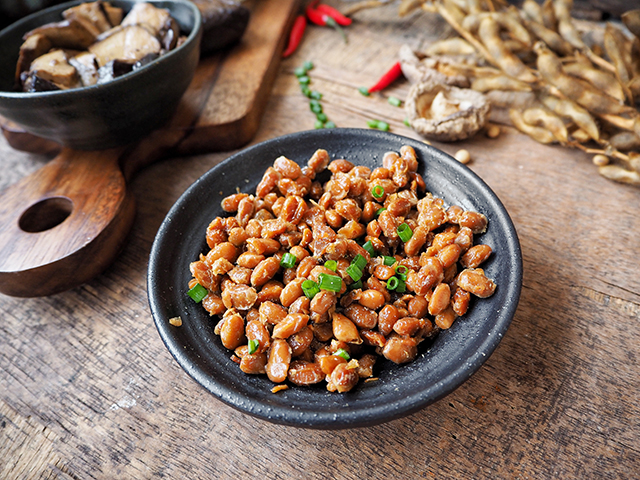
Advertisement
Prepackaged foods and heavily processed foods get a bad rap — and for good reason. Besides contributing very little to our nutritional needs, they’re also laden with the big no-no’s, i.e., sugar, salt and chemical additives that spell bad news for our health.
On the other hand, going for the same old healthy foods can become tiring at some point. After all — let’s face it — there’s something in those bags of chips and canned goods that just appeals to our taste buds and keeps us coming back for more.
So for those of you who get easily bored of eating the same things every week (or every other week), here are two new foods to try: natto and umeboshi. Besides their incredible health benefits and nutrition profiles, these Japanese health foods are sure to blow you away and chase away your food ennui.
Natto: a traditional Japanese superfood
Natto is a traditional Japanese dish that can be served alongside almost any kind of food, from cold noodles to sashimi. It is also a common ingredient used in Japanese dishes, such as sushi, salads and miso soup.
Made from fermented soybeans, natto has a strong, pungent smell reminiscent of cheese and old socks. Its characteristic slimy and sticky texture is also quite unlike any food you can name. For these reasons, natto can be an acquired taste for non-Japanese people.
But if you’re an adventurous eater, then you’ll be delighted to know that this health food contains plenty of essential nutrients. These include folate, a vitamin necessary for maternal and fetal health, and pantothenic acid, a nutrient necessary for making red blood cells.
But natto is perhaps most popular for its abundance in probiotics. Probiotics are friendly bacteria that support digestion, protect the gastrointestinal tract from infection and assist in the maintenance of gut health. These bacteria, together with the good ones that live in your gut, feed on soluble fiber, which natto conveniently contains.
According to the World Health Organization (WHO), the Japanese generally have low risks of heart disease, osteoporosis and cancer. Experts believe this is because of the diet most Japanese have — a diet that features staples like natto and other fermented foods.
Natto is also one of the richest sources of vitamin K2, a form of vitamin K that studies have linked to better heart health. What’s more, natto contains pyrroloquinoline quinone (PQQ), a plant nutrient that promotes healthy skin.
Natto can be eaten as-is for a quick and nutritious snack. You can also mix natto with miso soup to thicken it up and to neutralize natto’s pungent odor. If you’re looking to buy organic natto, you can find it in some health food stores or online.
The health secrets of umeboshi, an emerging superfood
Umeboshi is another popular fermented food in Japan. In English, umeboshi means “Japanese plums” or “pickled plums.” But don’t let the translation fool you. Umeboshi isn’t made from actual plums but from an unripe, sour fruit called ume that’s endemic to Japan.
Ume “plums” are salted and fermented before being served. Sometimes, however, they’re also mashed into a paste and added to sauces, dips and dressings.
Like natto, umeboshi is an acquired taste. In fact, it’s so sour that it’s not uncommon for people eating it for the first time to spit it out! But for those who are used to umeboshi’s characteristic sourness, this traditional Japanese delicacy can be an addictive snack.
The Japanese believe that eating umeboshi will prevent all sorts of illness because of the ume plums’ therapeutic and nutritional qualities. For starters, a single ume fruit contains about four milligrams (mg) of calcium, an essential mineral for bone health. Ume also contains a modest amount of iron that helps improve blood circulation.
In addition, the ume fruit has incredible amounts of citric acid, which is responsible for the tart, sour taste of citrus fruits. Citric acid also helps protect against disease-causing bacteria.
Benzoic acid is another naturally occurring acid that you can find in umeboshi. Because of its antibacterial properties, benzoic acid is often added to rice balls to keep the rice from going bad.
If you’re eating umeboshi for the first time, don’t eat it as is. The combination of extreme saltiness and sourness can be a lot for first-timers, so chop it up and sprinkle it over dishes until you get used to umeboshi’s strong flavor.
You might also come across umeboshi vinegar being sold as a seasoning. This form of umeboshi is perfect for creating salad dressings and dips.
Quick and simple recipe for natto and umeboshi pasta
Besides eating them as snacks or sides, natto and umeboshi also make for a great pasta sauce. You’ll get immune-boosting benefits by eating them together, so try this simple recipe for a delicious natto and umeboshi pasta.
Total time: 25 minutes
Ingredients:
- 160-200 grams pasta
- 2 Liters water
- 1 Tablespoon salt
- 1 Tablespoon olive oil
- 100 grams natto
- 2 pieces umeboshi
- 4 Tablespoons chopped green onions
- 4 Tablespoons shredded shiso or perilla leaves (optional)
Preparation:
- Cook the pasta until al dente.
- Drain and add olive oil to keep the strands from sticking.
- Chop and mash umeboshi into a paste.
- Combine the umeboshi paste with natto and two tablespoons of chopped green onions or shredded shiso.
- Mix the resulting sauce with the pasta.
- Sprinkle the remaining chopped green onions or shiso over the pasta and serve.
Natto and umeboshi are nutritious and delicious Japanese health foods that boast incredible health benefits. Eat them as part of a balanced diet and incorporate them into meals to boost your immunity and improve your overall health.
Sources:
Advertisements







